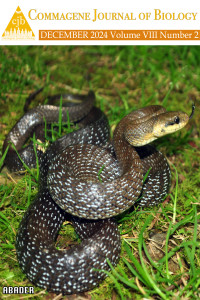Abstract
The present study aims to determine the covering setae in two crab spiders using scanning electron microscopy (SEM). The setae on the prosoma of Runcinia grammica (C. L. Koch, 1837) and Thomisus onustus Walckenaer, 1805 were examined. This study reveals a new type of covering setae in the members of Thomisidae family.
Keywords
References
- Baltayeva, H., Demir, H. & Seyyar, O. (2024). Do crab spiders (Araneae: Thomisidae) have the covering setae? Munis Entomology & Zoology, 19 (2), 1133-1135.
- Gawryszewski, F.M. (2014). Evidence suggests that modified setae of the crab spiders Stephanopis spp. fasten debris from the background. Zoomorphology, 133(2), 205-215. https://doi.org/10.1007/s00435-013-0213-4
- Ovtsharenko, V.I. (1985). Cuticular microstructure of the spider family Gnaphosidae (Aranei) and its use in the systematics. Proceedings of the Zoological Institute of the USSR Academy of Science, 139, 27-35 [in Russian].
- Ovtsharenko V.I. (1989). Microstructures on the cuticle of the spiders of the family Gnaphosidae (Arachnida, Aranei). In: Lange AB (ed.) [The fauna and ecology of spiders and scorpions. Collection of arachnological papers]. Nauka Publishers, Moscow. pp. 5-14 [in Russian].
- Townsend, V.R.Jr. & Felgenhauer, B.E. (1998). Cuticular scales of spiders. Invertebrate Biology, 117, 318–330. https://doi.org/10.2307/3227034
- Zakharov, B. & Ovtsharenko, V. (2015). The covering setae of ground spiders (Araneae: Gnaphosidae), Arachnologische Mitteilungen, 49, 34-46. https://doi.org/10.5431/aramit4904.
Abstract
Mevcut çalışmada taramalı elektron mikroskobu kullanılarak iki yengeç örümceği türünde örtü setalarının morfolojisinin belirlenmesi amaçlanmıştır. Runcinia grammica (C. L. Koch, 1837) ve Thomisus onustus Walckenaer, 1805 türlerinin prosomaları üzerindeki setalar bu amaçla incelenmiştir. Thomisidae familyası üyelerinde ilk kez görülen bir örtü setası tipine rastlanılmıştır.
Keywords
References
- Baltayeva, H., Demir, H. & Seyyar, O. (2024). Do crab spiders (Araneae: Thomisidae) have the covering setae? Munis Entomology & Zoology, 19 (2), 1133-1135.
- Gawryszewski, F.M. (2014). Evidence suggests that modified setae of the crab spiders Stephanopis spp. fasten debris from the background. Zoomorphology, 133(2), 205-215. https://doi.org/10.1007/s00435-013-0213-4
- Ovtsharenko, V.I. (1985). Cuticular microstructure of the spider family Gnaphosidae (Aranei) and its use in the systematics. Proceedings of the Zoological Institute of the USSR Academy of Science, 139, 27-35 [in Russian].
- Ovtsharenko V.I. (1989). Microstructures on the cuticle of the spiders of the family Gnaphosidae (Arachnida, Aranei). In: Lange AB (ed.) [The fauna and ecology of spiders and scorpions. Collection of arachnological papers]. Nauka Publishers, Moscow. pp. 5-14 [in Russian].
- Townsend, V.R.Jr. & Felgenhauer, B.E. (1998). Cuticular scales of spiders. Invertebrate Biology, 117, 318–330. https://doi.org/10.2307/3227034
- Zakharov, B. & Ovtsharenko, V. (2015). The covering setae of ground spiders (Araneae: Gnaphosidae), Arachnologische Mitteilungen, 49, 34-46. https://doi.org/10.5431/aramit4904.
Details
| Primary Language | English |
|---|---|
| Subjects | Zoology (Other) |
| Journal Section | Note |
| Authors | |
| Early Pub Date | October 1, 2024 |
| Publication Date | December 31, 2024 |
| Submission Date | June 27, 2024 |
| Acceptance Date | September 19, 2024 |
| Published in Issue | Year 2024 Volume: 8 Issue: 2 |
 This work is licensed under a Creative Commons Attribution-NonCommercial-ShareAlike 4.0 International License.
This work is licensed under a Creative Commons Attribution-NonCommercial-ShareAlike 4.0 International License.

